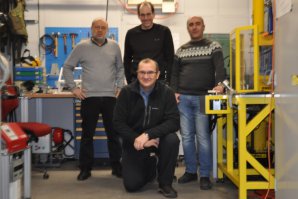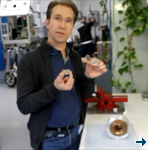Related News
High pressure research using muons at PSI
As part of the Sample Environment activities, a team at the Paul Scherrer Institute published a review of high pressure µSR experiments.
SINE2020, 24/01/2017
Contact: R. Khasanov, PSI
Scientists use muons to study how materials behave at the very small scale. By investigating how materials react to pressure changes, we can learn about ground states (the lowest energy state of an atom or of a collection of atoms forming a solid material), how the constituents of materials interact and behave, as well as determine their microscopic parameters. High pressure research has become one of the most significant fields in muon spin rotation/relaxation experiments (µSR).
Parameters for high pressure µSR experiments

The team at PSI. Left to right: Alex Amato, Matthias Elender, Zurab Shermadini. Sitting: Rustem Khasanov.
Muons are produced at large research infrastructures. One of those is the Paul Scherrer Institute (PSI) in Switzerland where, as part of the SINE2020 Activity on Sample Environment , a team published a review of high pressure µSR experiments. The paper addresses the following topics:
- Specific requirements and challenges to perform µSR experiments at high pressures
- High pressure setup at PSI
- Scientific examples
In summary, this work concludes that the most important parameters to perform successful µSR measurements under pressure are the following:
- Availability of a large volume of sample,
- Hydrostatic pressure conditions,
- Availability of low temperatures to study the ground state of condensed matter,
- Furthermore, it is advantageous to be able to perform pressure scans without opening the cell.
At present, the only practical choice for µSR experiments are piston-cylinder pressure cells, which provide a reasonable amount of sample space. The team at PSI is working on improving the characteristics of this type of cells within the boundary condition to use them in an existing sample and cryogenic environment. Their experimental tests reveal that more than 50% of the muons can be stopped in the sample by using a piston-cylinder pressure cell with 7 mm of inner diameter and about 30% for a 5 mm cell. On the other hand, given that 7 mm cells sustain less pressure than the 5 mm ones, the optimum choice of the specific pressure cell is dictated by the experimental requirements.
Applications of high pressure µSR
µSR is widely used for studies of magnetism such as, for example, to investigate microscopic magnetic properties of solids, for studying materials in which magnetic order is random or of short range, or samples containing multiple phases or which are partially magnetically ordered. The µSR technique is also a powerful tool to measure length scales of superconductors. µSR is a unique microscopic probe of vortex arrangement, fluctuations, pinning, flux-lattice melting, and the decomposition of flux lines into two-dimensional “pancake” vortices.
Benefits of taking part of SINE2020
Taking part of SINE2020 has important advantages for the PSI muon team. Funding through SINE2020 was essential for the team to start with optimising the pressure cells by performing the finite element analysis simulations. A key aspect is the possibility of exchanging knowledge and experiences with the world known pressure experts as well as to learn the technique by visiting pressure labs and facilities.
To learn about specific examples of the use of µSR for high pressure studies, please see the review published in the journal High Pressure Research, Volume 36, 2016 – Issue 2. http://dx.doi.org/10.1080/08957959.2016.1173690
Parameters for high pressure µSR experiments
Muons are produced at large research infrastructures. One of those is the Paul Scherrer Institute (PSI) in Switzerland where, as part of the SINE2020 Activity on Sample Environment , a team published a review of high pressure µSR experiments. The paper addresses the following topics:
- Specific requirements and challenges to perform µSR experiments at high pressures
- High pressure setup at PSI
- Scientific examples
In summary, this work concludes that the most important parameters to perform successful µSR measurements under pressure are the following:
- Availability of a large volume of sample,
- Hydrostatic pressure conditions,
- Availability of low temperatures to study the ground state of condensed matter,
- Furthermore, it is advantageous to be able to perform pressure scans without opening the cell.
At present, the only practical choice for µSR experiments are piston-cylinder pressure cells, which provide a reasonable amount of sample space. The team at PSI is working on improving the characteristics of this type of cells within the boundary condition to use them in an existing sample and cryogenic environment. Their experimental tests reveal that more than 50% of the muons can be stopped in the sample by using a piston-cylinder pressure cell with 7 mm of inner diameter and about 30% for a 5 mm cell. On the other hand, given that 7 mm cells sustain less pressure than the 5 mm ones, the optimum choice of the specific pressure cell is dictated by the experimental requirements.
Applications of high pressure µSR
µSR is widely used for studies of magnetism such as, for example, to investigate microscopic magnetic properties of solids, for studying materials in which magnetic order is random or of short range, or samples containing multiple phases or which are partially magnetically ordered. The µSR technique is also a powerful tool to measure length scales of superconductors. µSR is a unique microscopic probe of vortex arrangement, fluctuations, pinning, flux-lattice melting, and the decomposition of flux lines into two-dimensional “pancake” vortices.
Benefits of taking part of SINE2020
Taking part of SINE2020 has important advantages for the PSI muon team. Funding through SINE2020 was essential for the team to start with optimising the pressure cells by performing the finite element analysis simulations. A key aspect is the possibility of exchanging knowledge and experiences with the world known pressure experts as well as to learn the technique by visiting pressure labs and facilities.
Original Publication
To learn about specific examples of the use of µSR for high pressure studies, please see the review published in the journal High Pressure Research, Volume 36, 2016 – Issue 2. http://dx.doi.org/10.1080/08957959.2016.1173690


